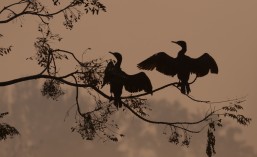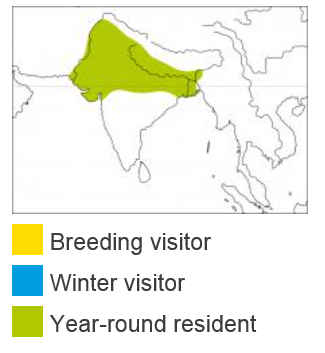Order: Passeriformes Family: Sturnidae Conservation Status: Least Concern
Description:
The Bank Myna is a medium sized bird measuring 20 to 24 cm in length and weighing 65 to 80 grams.
It has a black crown, wings and tail with slate-grey neck and mantle and pale grey underparts which become pale pink towards the centre of the abdomen. There is a small off-white wing patch at the base of the primary flight feathers and the tips of the outer tail feathers are also off-white. A small tuft of feathers can be seen on the forehead. The naked skin behind the eye is orange to brick-red whilst the iris itself is deep red. The beak and legs are orange-yellow.
There is no sexual dimorphism in adult birds.
Juvenile birds are similar to the adult but have a browner head and neck, paler throat and no forehead crest.
Call and Vocalisation:
Bank Mynas have a wide vocal repertoire including whistles, croaks, screeches, clucks and warbles. Its vocalisation can be quite persistent and perceived as constant chattering.
Range and Distribution:
The Bank Myna’s natural range is from the Himalayas (eastern Pakistan, northern India, southern Nepal, Bhutan) southwards through Bangladesh and central India towards the latitude of Mumbai. It is found at elevations of up to 1000 metres.
Within this range the species is mainly resident although some nomadic movements are recorded, driven by the weather and also food and water availability.
The range of the Bank Myna does seem to be expanding as the species extends further south within the Indian peninsula. Vagrant birds have been reported in Afghanistan.
Established introduced communities are recorded in Kuwait, United Arab Emirates, Saudi Arabia, the Maldives, Taiwan and Japan.

